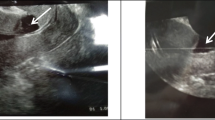Abstract
A Cesarean section scar pregnancy is a serious obstetric complication. For all treatment modalities there are risks of heavy bleeding and emergency hysterectomy. Here we report the use of the da Vinci robot for removal of the pregnancy with adequate bleeding control. A 36-year-old para-3 was diagnosed having a 11 + 3 week live cesarean scar pregnancy and a complete placenta previa. S-hCG was 52 726 IU/l. One week after methotrexate treatment the pregnancy was uneventfully and completely removed by robot-assisted laparoscopy with minimal blood loss. The uterine defect was repaired. Bleeding was controlled by temporary application of metal clips to the distal internal iliac arteries and the propria ligaments. Postoperative color Doppler ultrasonography revealed normal uterine blood flow, a repaired uterine defect, and no remaining pregnancy tissue. S-hCG was normalized (<3 IU/l) 38 days after surgery. Robot-assisted laparoscopic surgery with temporary occlusion of the main uterine blood supply is a feasible and safe technique for surgery of a Cesarean scar pregnancy.



Similar content being viewed by others

References
Jurkovic D, Hillaby K, Woelfer A et al (2003) First-trimester diagnosis and management of pregnancies implanted into the lower uterine segment Cesarean section scar. Ultrasound Obstet Gynecol 21:220–227. doi:10.1002/uog.56
Seow KM, Cheng WC, Chuang J et al (2004) Cesarean scar pregnancy: issues in management. Ultrasound Obstet Gynecol 23(3):247–253
Ash A, Smith A, Maxwell D (2007) Cesarean scar pregnancy. BJOG 114:253–263. doi:10.1111/j.1471-0528.2006.01237.x
Jurcovic D, Ben-Nagi D, Ofilly-Yebovi E et al (2007) Efficacy of Shirodkar cervical suture in securing hemostatis following surgical evacuation of cesarean scar ectopic pregnancy. Ultrasound Obstet Gynecol 30:65–100
Wang C-J, Yuen L-T, Chao A-S et al (2005) Cesarean scar pregnancy successfully treated by operative hysteroscopy and suction curettage. BJOG 112:839–840. doi:10.1111/j.1471-0528.2005.00532.x
Lee CL, Wang CJ, Chao A et al (1999) Laparoscopic management of an ectopic pregnancy in a previous Cesarean section scar. Hum Reprod 14:1234–1236. doi:10.1093/humrep/14.5.1234
Wang YL, SU T-H, Chen H-S (2006) Operative laparoscopy for unruptured ectopic pregnancy in a caesarean scar. BJOG 113:1035–1038. doi:10.1111/j.1471-0528.2006.01031.x
Persson J, Kannisto P, Bossmar T (2008) Robot-assisted abdominal laparoscopic radical trachelectomy. Gynecol Oncol 111(3):564–567
Palfalvi L, Ungar L, Boyle DMC et al (2003) Announcement of healthy boy born following abdominal radical trachelectomy. Int J Gynecol Cancer 13:250. doi:10.1046/j.1525-1438.2003.13060.x
Author information
Authors and Affiliations
Corresponding author
Rights and permissions
About this article
Cite this article
Persson, J., Gunnarson, G. & Lindahl, B. Robot-assisted laparoscopic surgery of a 12-week scar pregnancy with temporary occlusion of the uterine blood supply. J Robotic Surg 3, 53–55 (2009). https://doi.org/10.1007/s11701-009-0135-9
Received:
Accepted:
Published:
Issue Date:
DOI: https://doi.org/10.1007/s11701-009-0135-9



